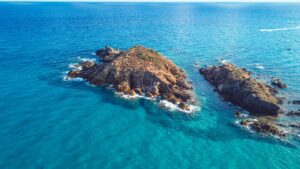Steeped in history and surrounded by the mesmerizing beauty of the Mediterranean, the Ancient City of Nora offers a unique glimpse into the past. This fascinating archaeological site is nestled within the Pula Archaeological Park, making it an essential destination for history buffs and travelers seeking to explore the rich heritage of Sardinia. In this comprehensive guide, you’ll learn everything you need to know about the Ancient City of Nora, including its historical significance, major attractions, and practical information for planning your visit.
Table of Contents
1. The Historical Significance of Nora
1.1. A Crossroads of Civilizations
Nora is considered one of the most important historical sites in Sardinia, thanks to its well-preserved ruins and the various civilizations that have inhabited the city over the centuries. Founded by the Nuragic people, the city reached its peak during the Punic and Roman eras, when it became a crucial trading hub in the Mediterranean.
1.2. A Wealth of Archaeological Discoveries
The site has been the focus of archaeological research since the late 19th century, yielding numerous fascinating discoveries. Among these is the Stele di Nora, an ancient stone tablet inscribed with one of the earliest known references to Sardinia (Shrdn). This priceless artifact, now housed in the Cagliari National Archaeological Museum, is a testament to the city’s long-standing connections with various Mediterranean cultures.
2. The Wonders of Nora: A Journey Through Time
2.1. Nuragic Origins and Punic Influence
While the Nuragic people founded Nora, it was during the Punic era that the city truly flourished. The Punic civilization, which originated in modern-day Tunisia, built a new city using the remains of the Nuragic settlement, transforming Nora into a bustling trade center.
2.2. The Tanit Temple and Tophet
One of the most intriguing structures in Nora is the so-called Tanit Temple, which is believed to have served a religious purpose. Although only the base structure and a pyramid-shaped stone altar remain, the temple offers a fascinating insight into the spiritual beliefs of the Punic people.
Nearby, you’ll find the Tophet, a sacred cemetery and ritual site dedicated to the Punic gods Tanit and Baal. Although partially submerged underwater, the Tophet remains an evocative reminder of the city’s ancient past.
2.3. Roman Conquest and Expansion
Following the Punic Wars, the Romans colonized Nora and transformed the city into a thriving Roman colony. With a population of around 8,000 inhabitants during the Imperial Era, the city boasted a wealth of Roman buildings and artifacts, many of which are still visible today.
3. Exploring the Ruins: Highlights of the Ancient City of Nora
3.1. Roman Baths and Architectural Marvels
One of the most striking features of Nora is its collection of Roman baths, which showcase the city’s penchant for opulent leisure. The Terme di Levante, Piccole Terme, Terme a mare, and Terme Centrali are all remnants of the city’s thriving bath culture.
3.2. The Foro, Aqueduct, and Amphitheater
As you wander the ancient streets of Nora, you’ll come across several impressive public buildings, including the Foro, a large courtyard that served as the heart of Roman politics. The city’s aqueduct system, which supplied water to both private homes and public spaces, is another testimony to the engineering prowess of the Romans.
3.3. The Roman Theater
Perhaps the most iconic structure in Nora is the Roman Theater, the only one of its kind in Sardinia. This remarkably well-preserved theater, which once accommodated up to 1,200 spectators, is still used today for concerts and performances during the summer months.
3.4. The Santuario di Esculapio
Another significant site within the city is the Santuario di Esculapio, a temple built atop a sacred Punic area at the southern end of the Nora Peninsula. The temple’s varied architectural styles reflect the Punic, Roman Republican, and Roman Imperial eras, offering a fascinating glimpse into the city’s evolving religious practices.
4. Practical Information for Visiting Nora
4.1. Getting There
Whether you’re traveling by car or public transportation, reaching the Ancient City of Nora is relatively straightforward. From Cagliari, you can take the SS 195 highway towards Pula-Teulada, arriving at Nora after roughly 30 kilometers (45 minutes of driving). Alternatively, you can take a bus from Cagliari’s ARST station to Pula, followed by a shuttle bus (known as the “pollicino”) to Nora.
4.2. Opening Hours and Tickets
The archaeological site is open daily, with summer hours from 9:00 am to 8:00 pm, and off-season hours from 9:00 am to one hour before sunset. Admission fees are €8 for adults, €4.50 for visitors aged 6-18, and free for children under 6. You’ll need to book your visit in advance through the Mobilitapp app or by emailing [email protected]
4.3. Rules and Regulations
When visiting Nora, please be respectful of the site’s historical significance by avoiding walking on mosaics, touching walls, or entering the site in swimwear. Dogs are permitted, provided they are on a leash.
5. Nearby Attractions: Making the Most of Your Visit
5.1. Nora Beach
Just a stone’s throw from the ancient city, Nora Beach is renowned for its crystal-clear waters and sheltered location, making it an ideal spot for a relaxing swim.
5.2. Sant’Efisio Church
This charming Romanesque church is an integral part of the annual Sant’Efisio rituals, which take place each May in Cagliari and Pula.
5.3. Torre del Coltellazzo
Built to defend the area against pirates, this imposing fort offers stunning views of the surrounding landscape.
6. Further Readings
To learn more about Sardinia’s rich history and cultural heritage, be sure to explore additional resources and articles on the subject.
In conclusion, a visit to the Ancient City of Nora is an essential experience for anyone seeking to uncover the rich history and natural beauty of Sardinia. With its captivating ruins, stunning landscapes, and fascinating past, Nora offers a unique opportunity to journey back in time and immerse yourself in the island’s captivating heritage.



